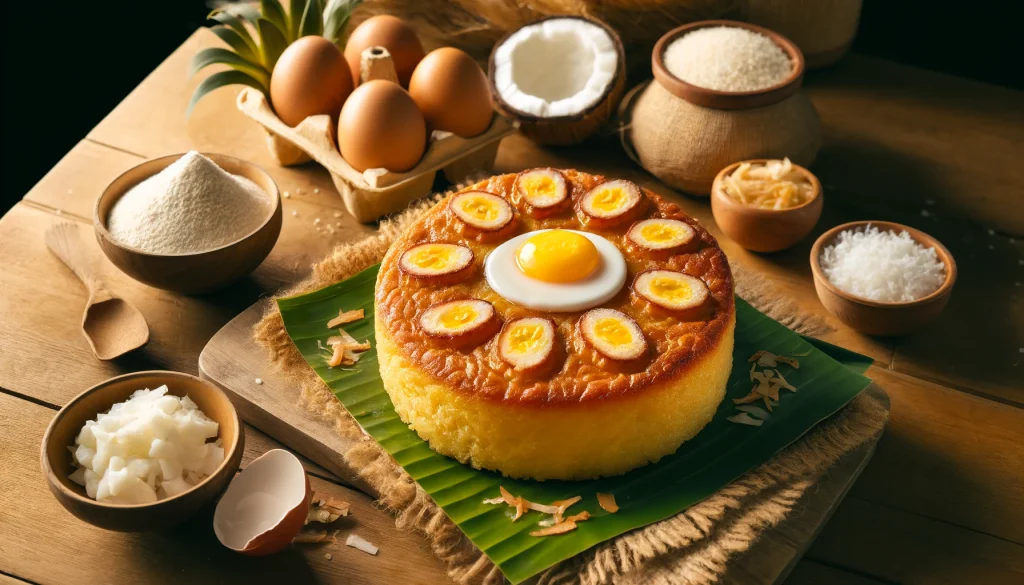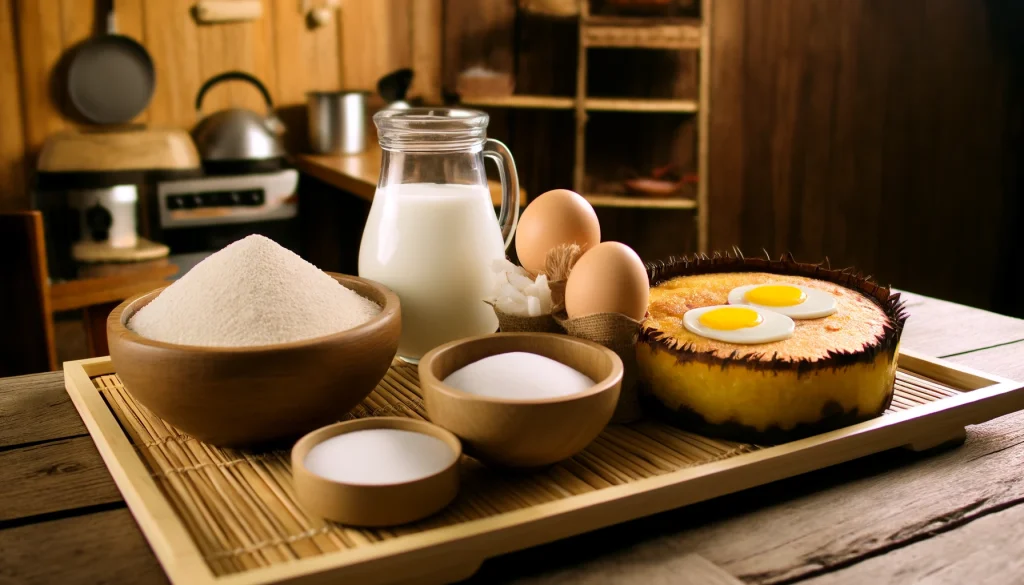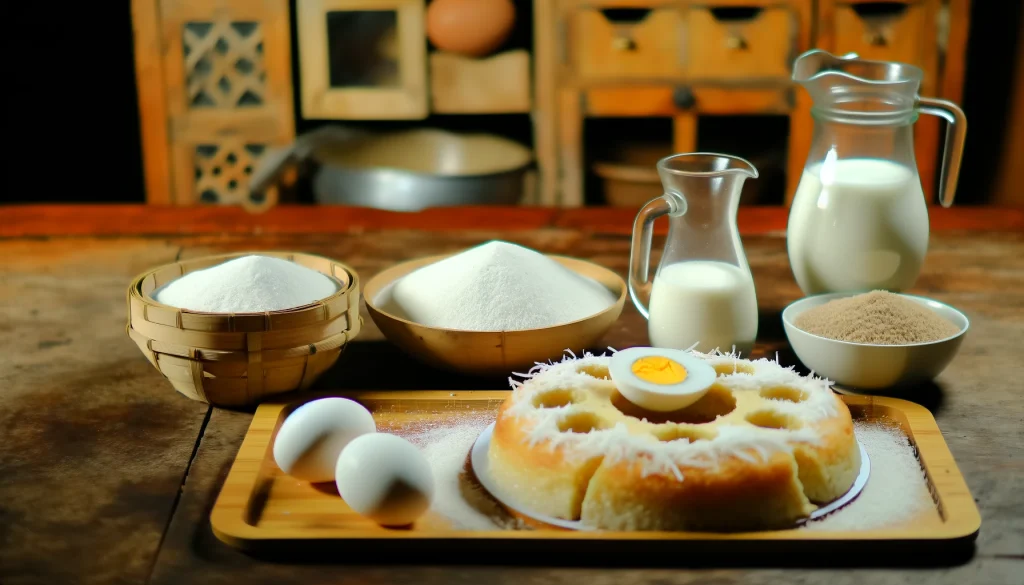As an Amazon Associate I earn from qualifying purchases.
Bibingka, a cherished culinary treasure from the Philippines, is a dish that embodies the warmth and richness of Filipino culture and tradition. This delightful rice cake, traditionally savored during the Christmas season, is a testament to the simplicity and elegance of Filipino baking. Made from a blend of rice flour, coconut milk, and eggs, and often cooked in a banana leaf, Bibingka offers a unique combination of textures and flavors that are both comforting and festive.
In this article, we will explore the art of making Bibingka, unveiling the secrets behind this beloved treat. From the selection of the right ingredients to the nuances of traditional cooking methods, each step in the preparation of Bibingka is a dance between the simplicity of rural Filipino life and the rich tapestry of its cultural heritage. Whether baked in a modern oven or cooked over coals in the traditional manner, Bibingka remains a symbol of celebration, bringing families together with its warm, sweet, and savory notes.
Join us as we delve into the recipe for Bibingka, unraveling the layers of this delectable cake that has captured the hearts and palates of Filipinos and food enthusiasts around the world. This guide promises to provide you with all the insights needed to recreate this festive delicacy, allowing you to experience the joy of Filipino culinary traditions in your own kitchen.
Bibingka Recipe

Bibingka is a traditional Filipino cake that’s especially popular during the Christmas season. It’s a sweet, moist cake made from rice flour and coconut milk, typically cooked in a banana leaf for a unique flavor. Here’s a basic recipe to make Bibingka at home:
Ingredients:
- Rice flour – 2 cups (You can use regular rice flour or glutinous rice flour for a chewier texture)
- Baking powder – 2 teaspoons
- Salt – ½ teaspoon
- Eggs – 3 large
- Granulated sugar – 1 cup
- Coconut milk – 1 ½ cups
- Fresh milk – ½ cup
- Melted butter – ½ cup, plus more for brushing
- Grated cheese – ½ cup (optional, for topping)
- Salted duck eggs – 2, sliced (optional, for topping)
- Freshly grated coconut (optional, for serving)
- Banana leaves (optional, for lining the baking pan)
Instructions:
Preparation:
- Preheat your oven to 350°F (175°C).
- Prepare a 9-inch round baking pan by lining it with banana leaves and brushing them with butter. If banana leaves are unavailable, simply grease the baking pan.
Mixing the Batter:
- In a bowl, sift together the rice flour, baking powder, and salt.
- In a separate larger bowl, beat the eggs and gradually add the sugar until well combined.
- Slowly add the dry ingredients to the egg mixture, alternating with the coconut milk and fresh milk, and mix until smooth.
- Stir in the melted butter.
Baking the Cake:
- Pour the batter into the prepared pan.
- Bake in the preheated oven for about 25-30 minutes, or until a toothpick inserted into the center of the cake comes out clean.
- Halfway through the baking, you can add toppings like grated cheese and sliced salted duck eggs on top of the cake.
Final Touches:
- Once baked, remove the Bibingka from the oven and brush the top with melted butter.
- You can also top it with more grated cheese and freshly grated coconut if desired.
Serving:
- Serve the Bibingka warm. It pairs wonderfully with coffee or a hot chocolate drink.
Enjoy your homemade Bibingka, a delightful treat that brings a taste of Filipino tradition to your kitchen!
TIPS
Creating the perfect Bibingka, a beloved Filipino rice cake, involves a blend of traditional techniques and a few modern twists. Here are some valuable tips to help you make a delicious Bibingka:
- Choice of Flour: Traditional Bibingka is made with rice flour, which gives it a distinct texture. You can use either regular rice flour for a softer cake or glutinous rice flour for a chewier consistency.
- Banana Leaves for Authentic Flavor: If you can get banana leaves, use them to line your baking pan. They impart a unique, aromatic flavor to the Bibingka that’s characteristic of the traditional version.
- Even Mixing of Ingredients: Ensure that the sugar is well beaten with the eggs before adding other ingredients. This helps to incorporate air and can result in a lighter texture.
- Oven Temperature Accuracy: Ensure your oven is correctly calibrated for the right temperature. Bibingka should be baked evenly for the perfect texture.
- Use of Toppings: Traditional toppings include salted duck eggs and grated cheese. Adding these halfway through the baking process prevents them from sinking into the batter and allows them to nicely melt into the top of the cake.
- Brushing with Butter: Brushing the Bibingka with butter right after baking gives it a wonderful sheen, enhances flavor, and adds moistness.
- Checking for Doneness: Use a toothpick or a skewer to check if the Bibingka is done. It should come out clean when inserted into the center of the cake.
- Serving: Bibingka is best served warm. It pairs excellently with traditional Filipino beverages like salabat (ginger tea) or hot chocolate.
- Storage: If you have leftovers, store them in an airtight container. They can be reheated in the microwave or oven.
- Experiment with Flavors: Feel free to add your twist with additional ingredients like coconut shavings, pandan essence, or even a sprinkle of brown sugar on top before baking for a caramelized crust.
Remember, making Bibingka is as much about the process as it is about the flavor. Enjoy the experience of bringing a piece of Filipino culinary tradition into your kitchen!
Why This Recipe Is Just So Good…

The Bibingka recipe is celebrated for several compelling reasons, making it a standout dish:
- Unique Texture: Bibingka offers a distinct texture that’s hard to find in other cakes. Depending on the flour used, it can be soft and fluffy or slightly chewy, providing a delightful mouthfeel.
- Aromatic Infusion: The use of banana leaves as a liner imparts a subtle, aromatic flavor that is uniquely Southeast Asian. This traditional method elevates the cake’s overall sensory experience.
- Balance of Flavors: The combination of slightly sweet cake with savory toppings like salted duck eggs and grated cheese creates a perfect balance of sweet and savory flavors, appealing to a wide range of palates.
- Versatile and Customizable: Bibingka is versatile in terms of toppings and mix-ins. You can add various toppings like grated coconut, cheese, or salted eggs, allowing for a range of flavors and textures.
- Cultural Significance: In the Philippines, Bibingka is not just a dish; it’s a part of cultural heritage, especially during the Christmas season. This cultural significance adds an intangible flavor to the recipe.
- Simple Ingredients, Rich Outcome: The recipe uses simple, accessible ingredients but delivers a rich and satisfying taste, making it a testament to the idea that great food doesn’t have to be complicated.
- Perfect for Any Occasion: Bibingka is suitable for a wide range of occasions, from everyday snacks to festive celebrations, making it a versatile choice.
- Comforting Quality: There’s a comforting, homely quality to Bibingka that makes it a favorite for many. It’s often associated with family gatherings and festive cheer.
- Nutritional Value: Made with rice flour and often topped with eggs and cheese, Bibingka provides a good balance of carbohydrates, protein, and fats.
- Easy to Make: Despite its exotic appeal, Bibingka is relatively easy to make, which adds to its charm. It’s a great way to introduce the flavors of Filipino cuisine to those unfamiliar with it.
In essence, Bibingka’s appeal lies in its unique combination of flavors and textures, ease of preparation, and its deep-rooted cultural significance, making it a beloved dish for both its taste and the traditions it represents.
Storage Instructions
Proper storage of Bibingka is important to maintain its freshness and taste. Here are some guidelines for storing this Filipino rice cake:
Short-Term Storage:
- Cool Down: Allow the Bibingka to cool to room temperature after baking. Do not cover it while it’s still warm, as this can create moisture and make the cake soggy.
- Refrigeration: If you’re not consuming the Bibingka immediately, wrap it in plastic wrap or aluminum foil, or place it in an airtight container to prevent it from drying out. Then, refrigerate.
- Shelf Life: Bibingka can be stored in the refrigerator for up to 3 days.
Long-Term Storage (Freezing):
- Freezing: For longer storage, Bibingka can be frozen. Wrap it tightly in plastic wrap and then in aluminum foil, or place it in a freezer-safe airtight container.
- Shelf Life: When stored in the freezer, Bibingka can last for about 1-2 months.
Thawing and Reheating:
- Thawing: Thaw frozen Bibingka in the refrigerator overnight or at room temperature for a few hours.
- Reheating: Reheat it in the microwave or oven until warm. If using an oven, cover the Bibingka with foil to prevent it from drying out.
General Tips:
- Avoid Repeated Reheating: Reheat only the amount you intend to eat. Repeated reheating can affect the texture and taste of the Bibingka.
- Check for Freshness: Always check for any signs of spoilage, like a sour smell or mold, especially if the Bibingka has been stored for a few days.
By following these storage instructions, you can enjoy your Bibingka at its best even after a few days, ensuring that its delightful taste and texture are preserved.
Frequently Asked Questions (FAQ’s)

Here are some expert-level questions and answers about making Bibingka, a traditional Filipino rice cake:
Q: What type of rice flour is best for Bibingka, and why?
A: For Bibingka, either regular rice flour or glutinous rice flour can be used. Regular rice flour yields a softer, cake-like texture, while glutinous rice flour provides a chewier, mochi-like consistency. The choice depends on personal preference for texture.
Q: How does the use of banana leaves affect the Bibingka?
A: Banana leaves impart a subtle, aromatic flavor to the Bibingka and prevent sticking. They also add to the traditional presentation. If unavailable, parchment paper can be used, but the unique flavor from the leaves will be missing.
Q: Can Bibingka be made without a traditional oven, and how?
A: Yes, Bibingka can be cooked in a large skillet or pan over a stovetop. Traditionally, it’s cooked in clay pots lined with banana leaves, with charcoal on top and bottom to create an oven-like effect. Cooking in a skillet requires careful heat management to cook evenly without burning.
Q: What is the role of coconut milk in the recipe, and are there any substitutes?
A: Coconut milk adds richness, moisture, and a distinct flavor to Bibingka. If coconut milk is not available, dairy milk or a mild non-dairy milk like almond milk can be used, although the traditional coconut flavor will be less pronounced.
Q: How can you tell when Bibingka is perfectly cooked?
A: Bibingka is perfectly cooked when it has a golden-brown top, and a skewer or toothpick inserted in the center comes out clean. The edges should be slightly crispy, with the interior remaining moist and fluffy.
Q: What are the best toppings for Bibingka, and when should they be added?
A: Traditional toppings include grated cheese, salted duck eggs, and grated coconut. They should be added in the last few minutes of baking to avoid overcooking. The cheese should be melted but not burned, and the salted egg adds a savory contrast.
Q: Can Bibingka batter be prepared in advance?
A: Yes, Bibingka batter can be prepared a few hours in advance and refrigerated. However, it should be brought back to room temperature before baking for even cooking.
These questions and answers delve into the more nuanced aspects of preparing Bibingka, highlighting the importance of ingredient selection, cooking techniques, and traditional practices in achieving the authentic taste and texture of this beloved Filipino dessert.
Conclusion
In conclusion, Bibingka is more than just a dessert; it’s a celebration of Filipino culture, tradition, and the flavors that bring people together. This beloved rice cake, with its golden-brown crust, tender crumb, and delightful toppings, is a symbol of warmth, festivity, and togetherness.
As we conclude our exploration of this classic Bibingka recipe, it’s evident that the beauty of this dish lies not only in its taste but also in its ability to connect us to the rich culinary heritage of the Philippines. Each bite carries with it a piece of tradition and a sense of belonging, whether enjoyed during Christmas festivities or as a simple pleasure any day of the year.
So, the next time you prepare Bibingka, take a moment to savor not only its deliciousness but also the cultural significance it represents. Share it with loved ones, create memories, and continue the tradition of appreciating the simple joys that food can bring to our lives. Bibingka is not just a recipe; it’s a story of love, family, and the enduring flavors of the Philippines.






